1998 CADILLAC ELDORADO key
[x] Cancel search: keyPage 87 of 380
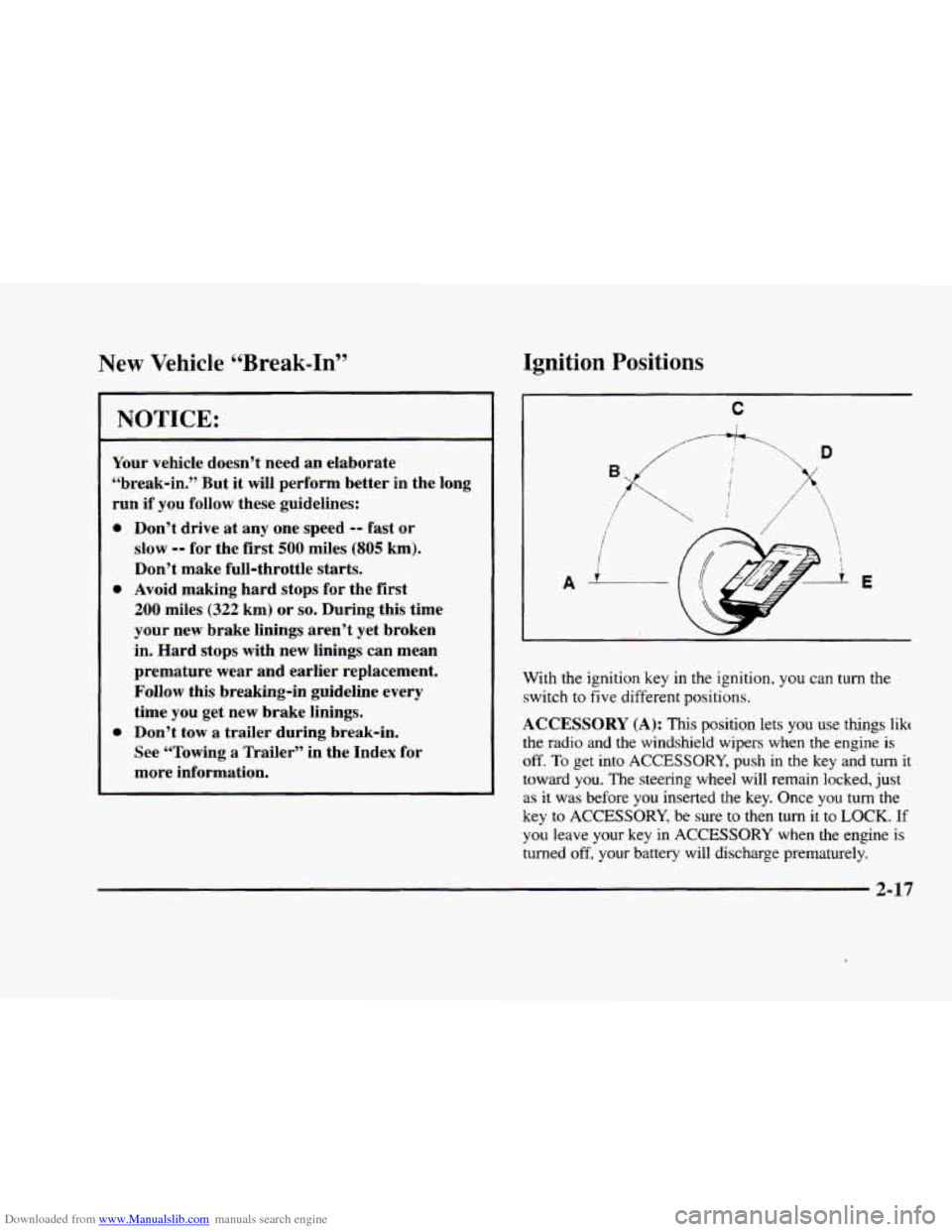
Downloaded from www.Manualslib.com manuals search engine New Vehicle “Break-In” Ignition Positions
NOTICE:
Your vehicle doesn’t need an elaborate
“break-in.” But it will perform better in the long
run if you follow these guidelines:
0
0
0
Don’t drive at any one speed -- fast or
slow
-- for the first 500 miles (805 km).
Don’t make full-throttle starts.
Avoid making hard stops for the first
200 miles (322 km) or so. During this time
your new brake linings aren’t yet broken
in. Hard stops with new linings can mean
premature wear and earlier replacement.
Follow this breaking-in guideline every
time you get new brake linings.
Don’t tow a trailer during break-in.
See “Towing
a Trailer” in the Index for
more information.
C
i
i
A L E
With the ignition key in the ignition, you can turn the
switch to five different positions.
ACCESSORY (A): This position lets you use thmgs likt
the radio and the windsheld wipers when the engine is
off. To get into ACCESSORY, push in the key and turn it
toward you. The steering wheel will remain locked, just
as it was before you inserted the key. Once you turn the
key
to ACCESSORY, be sure to then turn it to LOCK. If
you leave your key in ACCESSORY when the engine
is
turned off, your battery will discharge prematurely.
2-17
Page 88 of 380

Downloaded from www.Manualslib.com manuals search engine LOCK (B): Before you put the key in, the ignition will
be in LOCK. This
is the only position in which you can
remove the key. This position
locks the ignition, steering
wheel and transaxle. It’s a theft-deterrent feature.
NOTICE:
If your key seems stuck in LOCK and you can’t
turn it,
be sure you are using the correct key; if
so, is it all the way in? If it is, then turn the
steering wheel left and right while you turn the
key hard. But turn the key only with your hand.
Using
a tool to force it could break the key or the
ignition switch.
If none of this works, then your
vehicle needs service.
OFF (C): This position lets you turn off the engine but
still turn the steering wheel. It doesn’t lock the steering
wheel like LOCK does. Use
OFF if you must have your
vehicle in motion while the engine
is off (for example, if
your vehicle is being pushed).
RUN (D): This is the position for driving.
START (E): This position starts the engine.
Retained Accessory Power (RAP)
The following accessories on your vehicle may be used
for up
to 10 minutes after the ignition key is turned from
RUN to OFF, and then to LOCK:
0 Radio
Power Windows
Astroroof
Power to these accessories stops after
10 minutes or if
either door is opened. If you want power for another
10 minutes, turn the ignition key to RUN, OFF and
then
to LOCK.
NOTICE:
When using RAP, always leave your key in
LOCK. If you leave your key in any other
position than
LOCK, your battery will discharge
prematurely.
2-18
Page 89 of 380
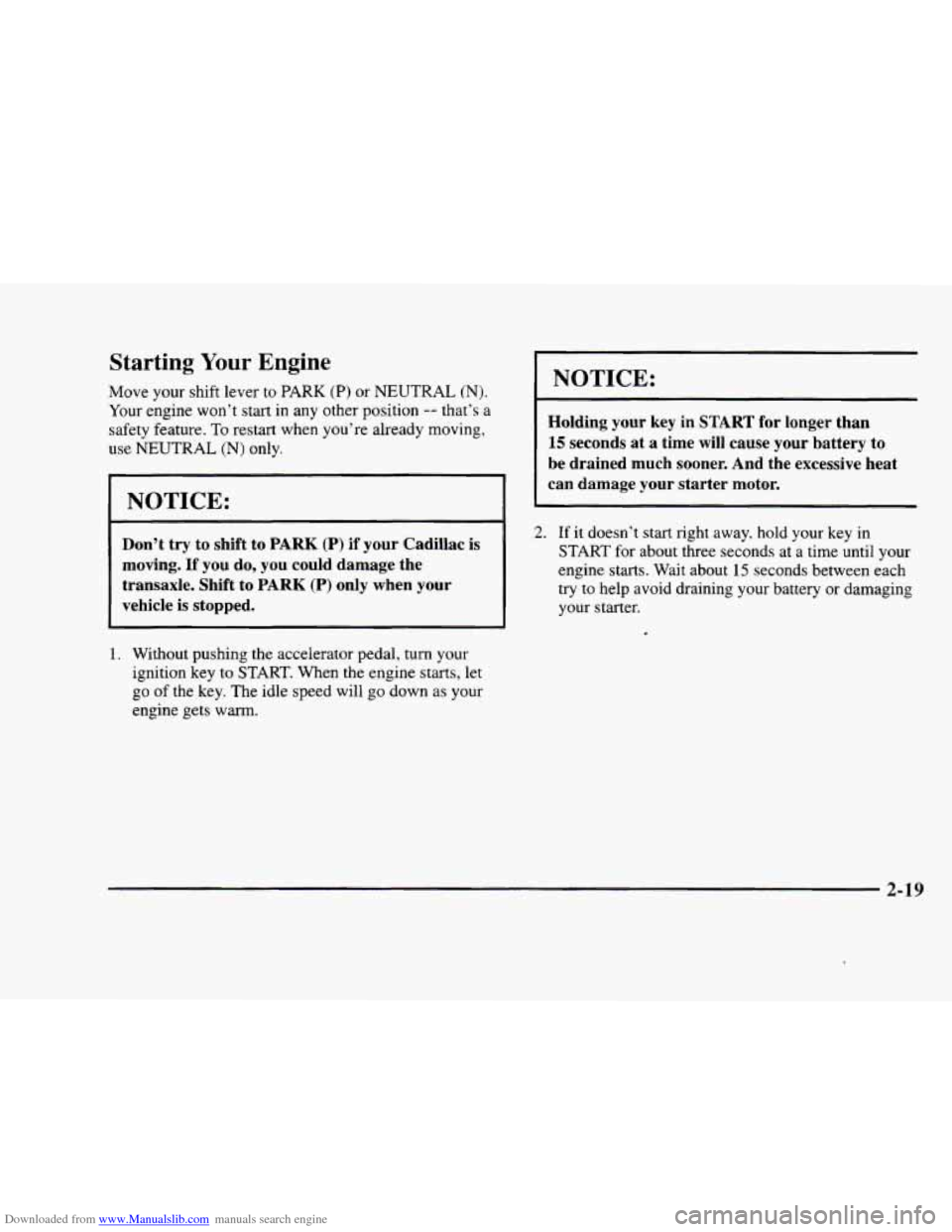
Downloaded from www.Manualslib.com manuals search engine Starting Your Engine
Move your shift lever to PARK (P) or NEUTRAL (N).
Your engine won’t start in any other position -- that’s a
safety feature. To restart when you’re already moving,
use
NEUTRAL (N) only.
I NOTICE:
Don’t try to shift to PARK (P) if your Cadillac is
moving.
If you do, you could damage the
transaxle. Shift to
PARK (P) only when your
vehicle
is stopped.
I. Without pushing the accelerator pedal, turn your
ignition key to START. When the engine
starts, let
go of the key. The idle speed will
go down as your
engine gets
warm.
1 NOTICE:
Holding your key in START for longer than
15 seconds at a time will cause your battery to
be drained much sooner. And the excessive heat
can damage your starter motor.
~ 2. If it doesn’t start right away. hold your key in
START for about three seconds at a time until your
engine starts. Wait about
15 seconds between each
try to help avoid draining your battery or damaging
your starter.
2-19
Page 90 of 380
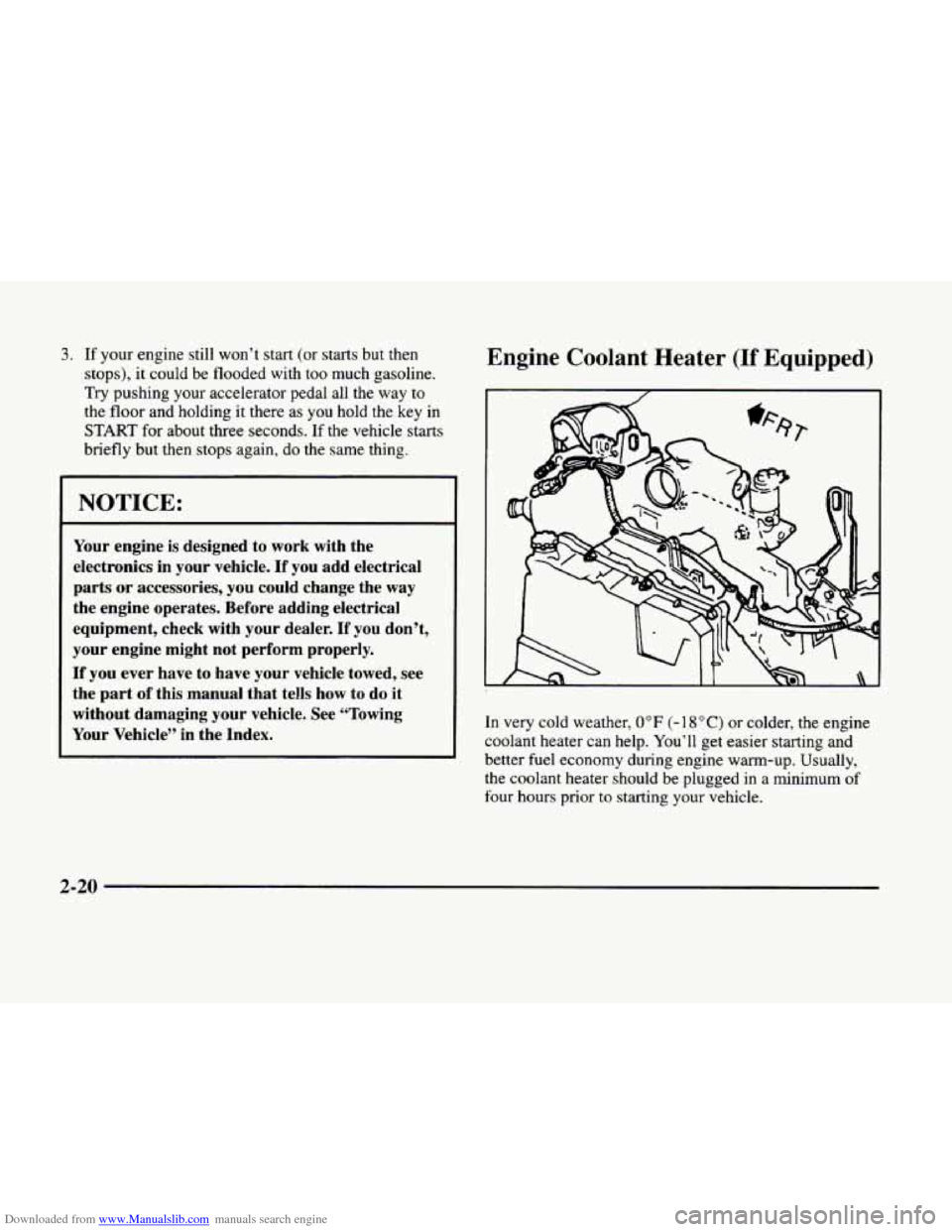
Downloaded from www.Manualslib.com manuals search engine 3. If your engine still won’t start (or starts but then
stops), it could be flooded with too much gasoline.
Try pushing your accelerator pedal all the way to
the floor and holding it there as you hold the key in
START for about three seconds. If the vehicle starts
briefly but then stops again, do the same thing.
NOTICE: I
Your engine is designed to work with the
electronics in your vehicle.
If you add electrical
parts
or accessories, you could change the way
the engine operates. Before adding electrical
equipment, check with your dealer.
If you don’t,
your engine might not perform properly.
If you ever have to have your vehicle towed, see
the part
of this manual that tells how to do it
without damaging
your vehicle. See “Towing
Your Vehicle”
in the Index.
Engine Coolant Heater (If Equipped)
In very cold weather, 0°F (- 18OC) or colder, the engine
coolant heater can help.
You’ll get easier starting and
better fuel economy during engine
warm-up. Usually,
the coolant heater should be plugged in a minimum of
four hours prior to starting your vehicle.
2-20
Page 92 of 380
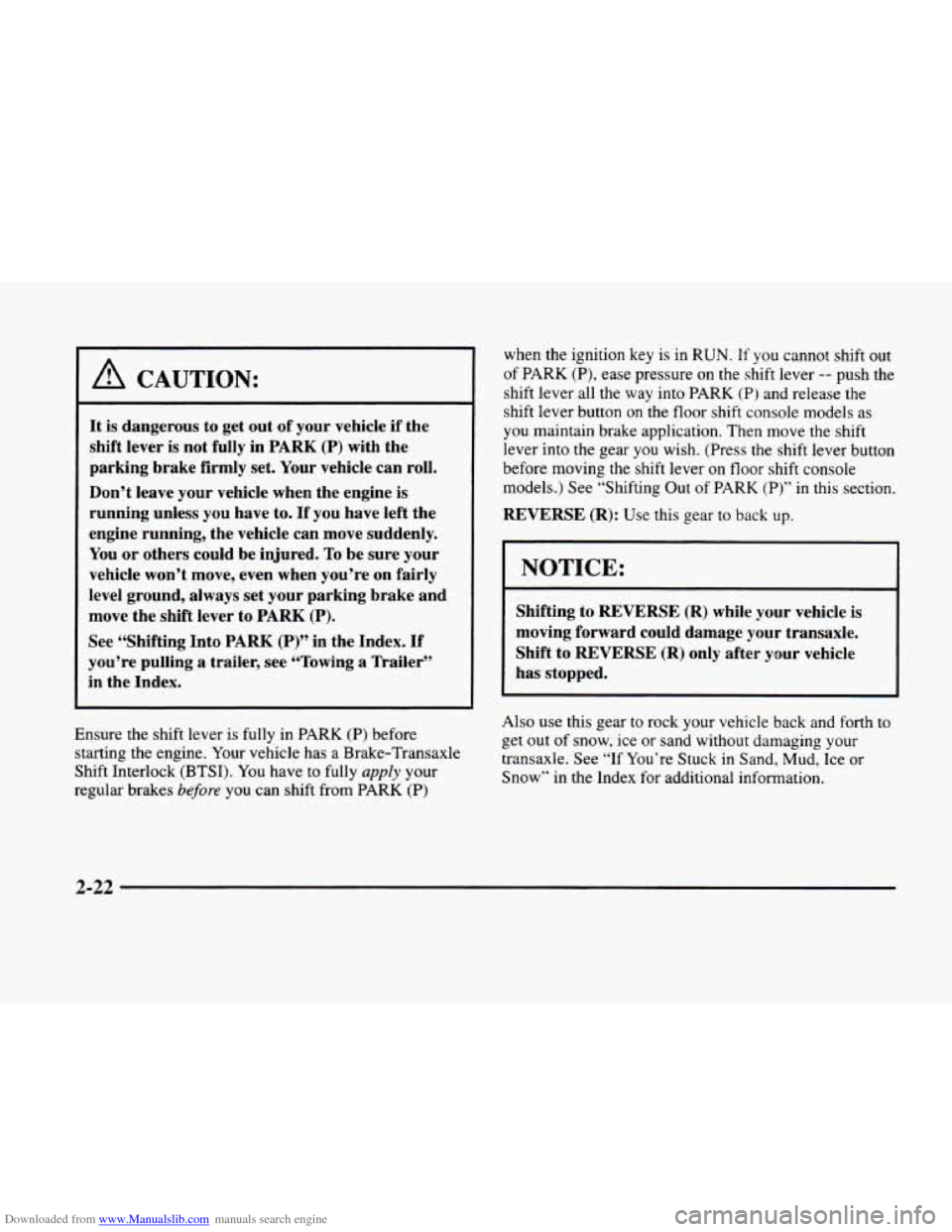
Downloaded from www.Manualslib.com manuals search engine 1 A CAUTION:
’ It is dangerous to get out of your vehicle if the
shift lever is not fully in PARK (P) with the
parking brake firmly set. Your vehicle can roll.
Don’t leave your vehicle when the engine is
running unless you have to.
If you have left the
engine running, the vehicle can move suddenly.
You or others could be injured.
To be sure your
vehicle won’t move, even when you’re on
fairly
level ground, always set your parking brake and
move the shift lever to PARK
(P).
See “Shifting Into PARK (P)” in the Index. If
you’re pulling a trailer, see “Towing a nailer”
in the Index.
Ensure the shift lever is fully in PARK (P) before
starting the engine. Your vehicle has a Brake-Transaxle
Shift Interlock (BTSI). You have to fully
apply your
regular brakes
before you can shift from PARK (P)
when the ignition key is in RUN. If you cannot shift out
of PARK (P), ease pressure on the shift lever -- push the
shift lever all the way into
PARK (P) and release the
shift lever button
on the floor shift console models as
you maintain brake application. Then move the shift
lever into
the gear you wish. (Press the shift lever button
before moving the shift lever
on floor shift console
models.)
See “Shifting Out of PARK (P)” in this section.
REVERSE (R): Use this gear to back up.
NOTICE:
Shifting to REVERSE (R) while your vehicle is
moving forward could damage your transaxle.
Shift to REVERSE
(R) only after your vehicle
has stopped.
Also use this gear to rock your vehicle back and forth to
get out of snow, ice or sand without damaging your
transaxle. See “If You’re Stuck in Sand,
Mud, Ice or
Snow” in the lndex for additional information.
2-22
Page 97 of 380
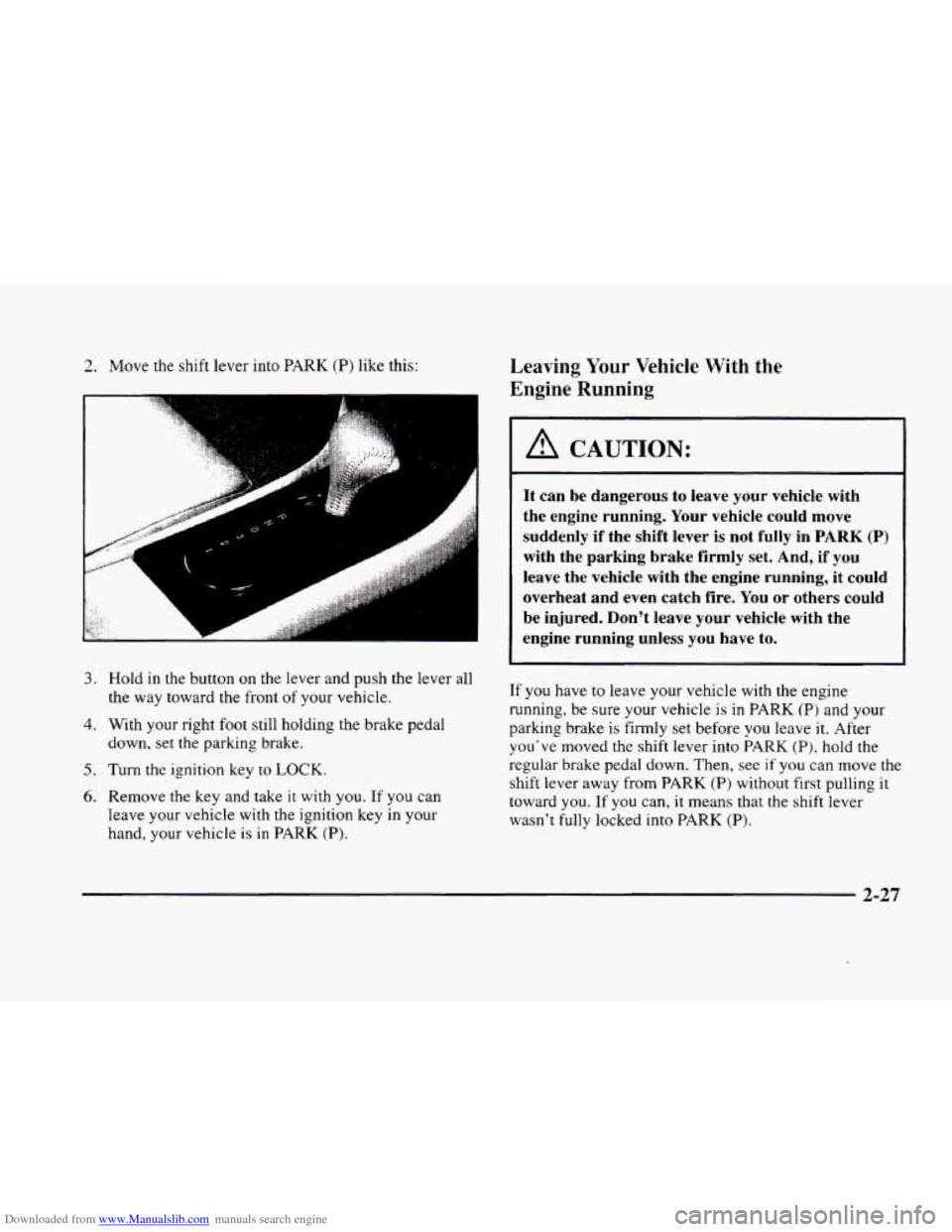
Downloaded from www.Manualslib.com manuals search engine 2. Move the shift lever into PARK (P) like this:
3. Hold in the button on the lever and push the lever all
4. With your right foot still holding the brake pedal
down, set the parking brake.
5. Turn the ignition key to LOCK.
6. Remove the key and take it with you. If you can
leave your vehicle with the ignition key in your
hand, your vehicle
is in PARK (P).
the way toward the front of your vehicle.
Leaving Your Vehicle With the
Engine Running
A CAUTION:
It can be dangerous to leave your vehicle with
the engine running. Your vehicle could move
suddenly if the shift lever is not fully in
PARK (P)
with the parking brake firmly set. And, if you
leave the vehicle with the engine running, it could
overheat and even catch fire. You or others could
be injured. Don't leave your vehicle with the
engine running unless you have to.
If you have to leave your vehicle with the engine
running. be sure your vehicle
is in PARK (P) and your
parking brake is firmly set before
you leave it. After
you've moved the shift lever into PARK
(P), hold the
regular brake pedal down. Then, see if
you can move the
shift lever away from PARK (P) without first pulling it
toward
you. If you can, it means that the shift lever
wasn't fully locked into PARK
(P).
2-27
Page 98 of 380
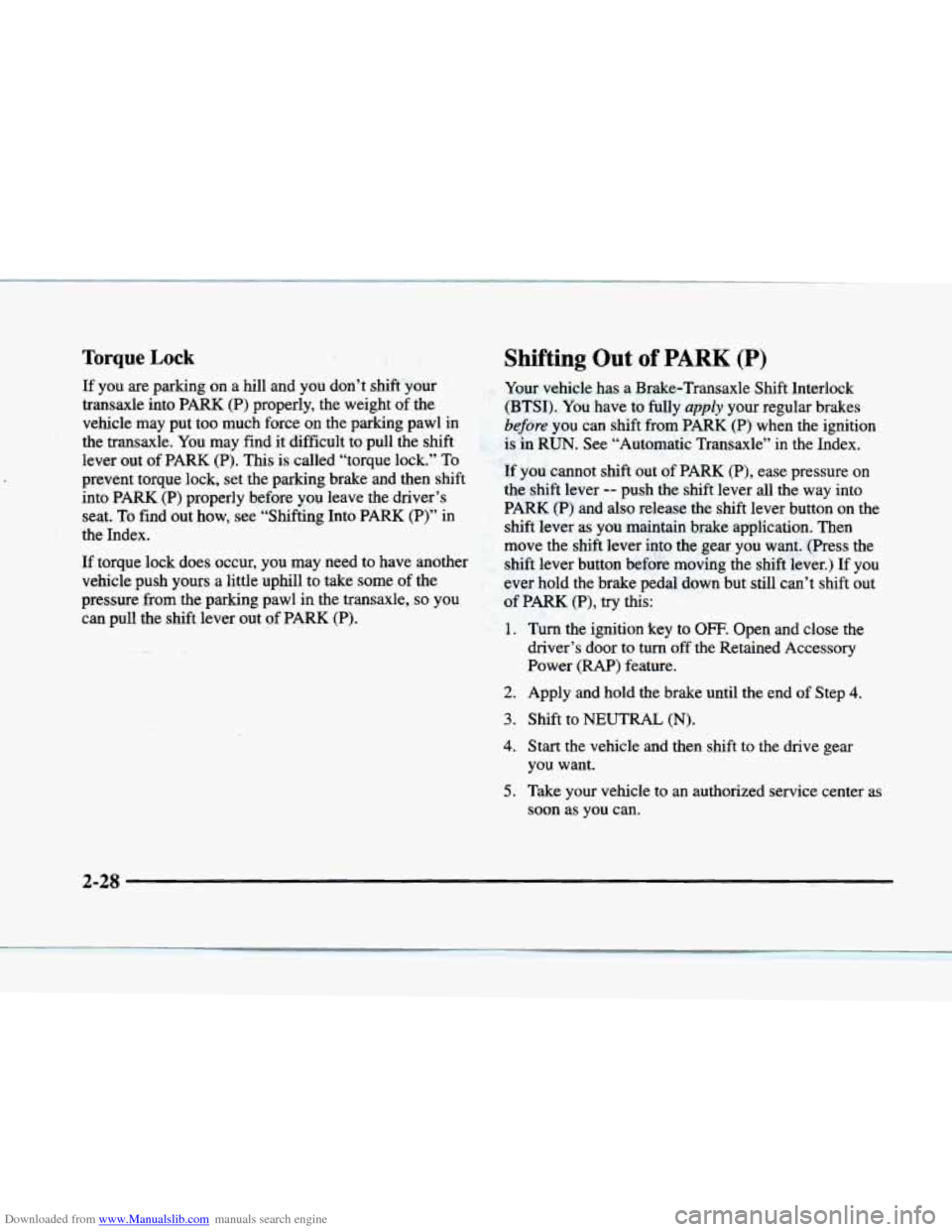
Downloaded from www.Manualslib.com manuals search engine Torque Lock
If you are parking on a hill and you don’t shift your
transaxle into PARK
(P) properly, the weight of .the
vehicle may put too much force on the parking pawl in
the transaxle. You may find it difficult to pull the shift
lever out of PARK (P).
This is called “torque lock.” To
prevent torque lock, set the parking brake and then shift
into PARK
(P) properly before you leave the driver’s
seat. To find out how, see “Shifting Into PARK (P)” in
the Index.
If torque lock does occur, you may need to have another
vehicle push yours a little uphill to take some of the
pressure from the parking pawl in the transaxle,
so you
can pull the shift lever out
of PARK (P).
. -._
Shifting Out of PARK (P)
Your vehicle has a Brake-Transaxle Shift Interlock
(BTSI). You have to fully
apply your regular brakes
before you can shift from PARK (P) when the ignition
is in
RUN. See “Automatic Transaxle” in the Index.
If you cannot shift out of PARK (P), ease pressure on
the shift lever
-- push the shift lever all the way into
PARK
(P) and also release the shift lever button on the
shift lever as you maintain brake application. Then
move the shift lever into the gear you want. (Press the
shift lever button before moving the shift-lever.) If you
ever hold the brake pedal down but still can’t shift out
of PARK (P), try this:
1.
2.
3.
4.
5.
Turn the ignition key to OFF. Open and close the
driver’s door to turn
off the Retained Accessory
Power
(RAP) feature.
Apply and hold the brake until the end of Step
4.
Shift to NEUTRAL (N).
Start the vehicle and then shift to the drive gear
you want.
Take your vehicle to an authorized service center as
soon as you can.
2-28
Page 101 of 380
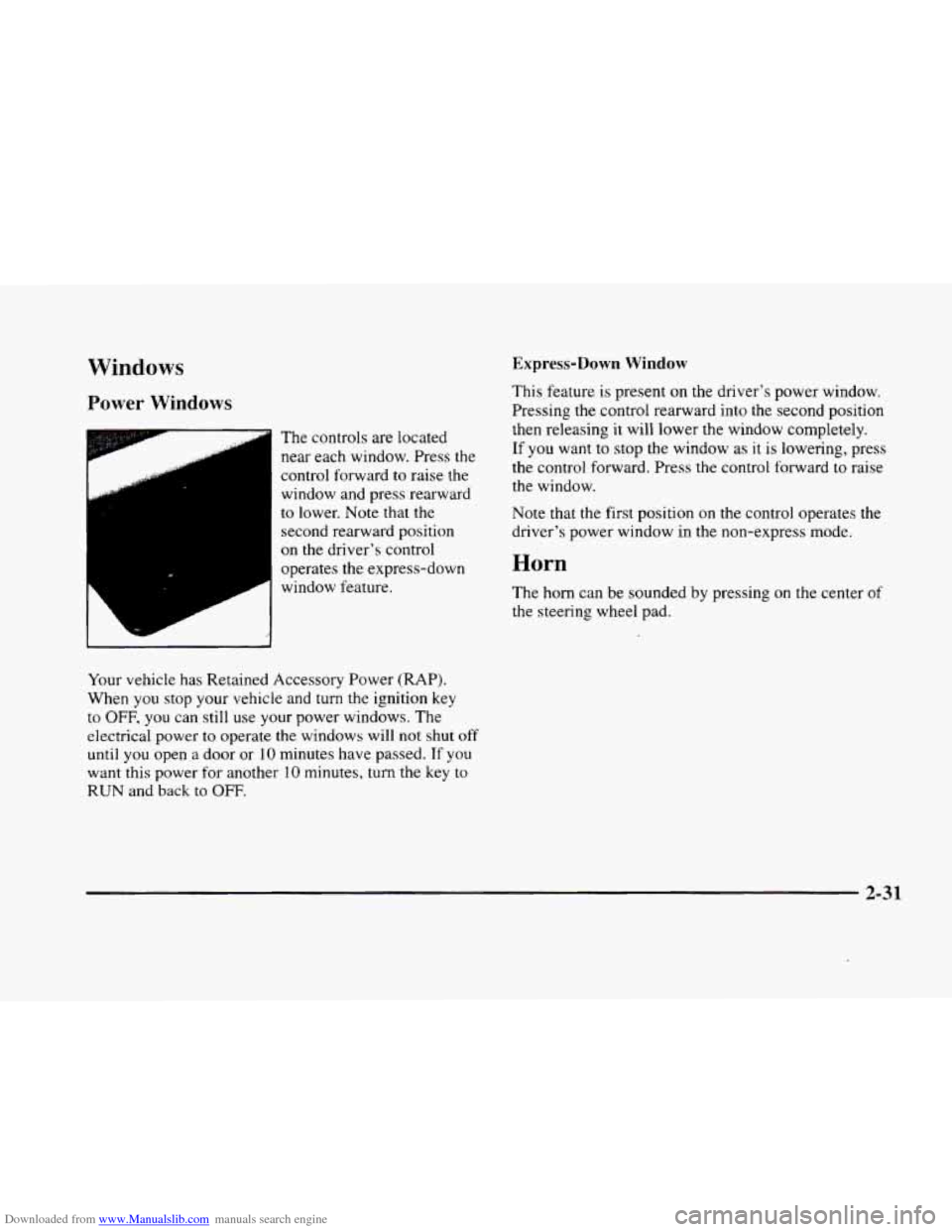
Downloaded from www.Manualslib.com manuals search engine Windows Express-Down Window
Power Windows
F-
,.. .
The controls are located
near each window. Press the
control forward
to raise the
window and press rearward
to lower. Note that the
second rearward position
on the driver's control
operates the express-down
window feature.
Your vehicle has Retained Accessory Power
(RAP).
When you stop your vehicle and turn the ignition key
to
OFF, you can still use your power windows. The
electrical power
to operate the windows will not shut off
until you open a door or 10 minutes have passed. If you
want this power for another
10 minutes, turn the key to
RUN and back to OFF.
This feature is present on the driver's power window.
Pressing the control rearward into the second position
then releasing
it will lower the window completely.
If you want to stop the window as it is lowering, press
the control forward. Press the control forward
to raise
the window.
Note that the first position
on the control operates the
driver's power window in the non-express mode.
Horn
The horn can be sounded by pressing on the center of
the steering wheel pad.
2-31